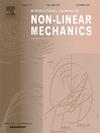单晶硅超低速提升运动的摩擦建模与参数辨识
IF 2.8
3区 工程技术
Q2 MECHANICS
International Journal of Non-Linear Mechanics
Pub Date : 2025-03-21
DOI:10.1016/j.ijnonlinmec.2025.105081
引用次数: 0
摘要
在Czochralski晶体生长过程中,单晶硅(SCS)锭在整个过程中被拉出并以超低速度旋转,每批持续100小时左右。然而,非线性摩擦扰动会导致悬架提升伺服系统的速度抖动和爬行现象,进而影响生产的悬架质量。经典的LuGre摩擦模型只考虑了速度因素,因此不能完全描述复杂的SCS升降伺服系统的摩擦特性。为了解决这一限制,本文提出了一个改进的LuGre摩擦模型,该模型考虑了SCS锭的重量变化和旋转的影响。此外,提出了一种参数辨识方法来估计摩擦模型的参数。为了克服传统优化算法在多维参数空间中容易陷入局部最优和收敛速度慢的问题,本研究将参数辨识分为静态和动态两个阶段。特别是在动态阶段,采用改进的粒子群优化算法,采用混沌映射和惯性权值非线性变化策略,提高了优化过程的精度和收敛速度。在SCS升降伺服系统上的实验结果表明了该方法的有效性。本文章由计算机程序翻译,如有差异,请以英文原文为准。
Friction modeling and parameter identification for ultra-low-speed lifting motion of single-crystal silicon
In the Czochralski crystal growth process, a single-crystal silicon (SCS) ingot is pulled and rotated at an ultra-low speed during the entire process, which lasts around a hundred hours per batch. However, nonlinear friction disturbances can lead to speed jitter and creeping phenomena of an SCS lifting servo system, which can further affect the produced SCS’s quality. The classical LuGre friction model considers only the speed factor and, thus, cannot fully describe the friction characteristics of a complex SCS lifting servo system. To address this limitation, this paper proposes an improved LuGre friction model that considers the effects of weight variations and rotation of an SCS ingot. In addition, a parameter identification method is developed to estimate the friction model’s parameters. To overcome the problems in traditional optimization algorithms of easy falling into a local optimum and a slow convergence speed in multi-dimensional parameter space, this study divides the parameter identification into two stages: static and dynamic stages. Particularly, in the dynamic stage, an improved particle swarm optimization algorithm, which adopts a chaotic mapping and inertia weight nonlinear change strategy, is employed to improve the precision and convergence rate of the optimization process. The results of the experiments on an SCS lifting servo system demonstrate the high efficiency of the proposed method.
求助全文
通过发布文献求助,成功后即可免费获取论文全文。
去求助
来源期刊
CiteScore
5.50
自引率
9.40%
发文量
192
审稿时长
67 days
期刊介绍:
The International Journal of Non-Linear Mechanics provides a specific medium for dissemination of high-quality research results in the various areas of theoretical, applied, and experimental mechanics of solids, fluids, structures, and systems where the phenomena are inherently non-linear.
The journal brings together original results in non-linear problems in elasticity, plasticity, dynamics, vibrations, wave-propagation, rheology, fluid-structure interaction systems, stability, biomechanics, micro- and nano-structures, materials, metamaterials, and in other diverse areas.
Papers may be analytical, computational or experimental in nature. Treatments of non-linear differential equations wherein solutions and properties of solutions are emphasized but physical aspects are not adequately relevant, will not be considered for possible publication. Both deterministic and stochastic approaches are fostered. Contributions pertaining to both established and emerging fields are encouraged.

 求助内容:
求助内容: 应助结果提醒方式:
应助结果提醒方式:


